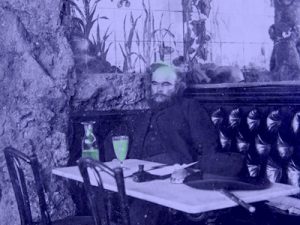
A couple of really great finds for you today …
My temperature was no better than lukewarm as I pondered the cover of a book called The Cool School: Writing from America’s Hip Underground, a Library of America anthology edited by Glenn O’Brien. The Library of America isn’t known for edginess, and books with the word “hip” in their subtitles don’t have the greatest track record with me.
Then I looked at the table of contents and immediately realized I had misjudged this book. Wow! We kick off with an excerpt from Mezz Mezzrow’s classic jazz memoir Really The Blues, a hell of a good place to start, and instant evidence of an anthologist who knows his stuff. Then we blast away to Henry Miller, Herbert Huncke and Carl Solomon, a sweet rumination on Shakespeare’s Hamlet by Delmore Schwartz, followed by “You’re Too Hip, Baby” by Terry Southern … and then just as I start to wonder where the cool women are, a real surprise: the lyrics to the 1952 song “Twisted” by Annie Ross of the now too-little-remembered folk/hipster trio Lambert, Hendricks and Ross, a comic tune later resurrected by Joni Mitchell that begins with this line:
My analyst told me that I was right out of my head
At this point, there is no doubt that Glenn O’Brien has exceeded his assignment and met the challenge of producing a fresh, sharp literary anthology of cool with more beatnik accuracy and hipster knowledge than anyone could expect. We proceed with moments from Lord Buckley, Gregory Corso, Diane Di Prima, Norman Mailer, Amira Baraka, Fran Landesman, Seymour Krim, Mort Sahl, the well-titled “Siobhnan McKenna Group-Grope” by Ed Sanders, and more from Rudolph Wulitzer, Ishmael Reed, Richard Brautigan, Andy Warhol, Richard Hell, Lynne Tillman, Emily XYZ, Eric Bogosian and (the closer) George Carlin.
Nailed it! If a table of contents can sing, this one is jamming.
I’ve already raved on this blog about Russ Kick’s ambitious project The Graphic Canon, a super-thick multi-volume collection of illustrated spinoffs, takeoffs and impressionist interpretations of great literature from planet Earth. What most impressed me about the first two chronologically-ordered volumes was the broad multi-cultural view of world literature, encompassing illustrated versions of spiritual and religious classics, surprising philosophy texts and plenty of unexpected works of fiction and poetry. The quality of the selections is due to the good taste of Russ Kick, who is far from a member of any academy and was previously the author of You Are Being Lied To: The Disinformation Guide to Media Distortion, Historical Whitewashes and Cultural Myths.
The series has now been completed with the publication of The Graphic Canon, Vol. 3: From Heart of Darkness to Hemingway to Infinite Jest, which begins in the Victorian/pre-modernist era with Matt Kish’s dreamy spin on Joseph Conrad’s Heart of Darkness and Rebecca Migdal’s gentle take on Kate Chopin’s The Awakening. It ends with a painting by Rey Ortega inspired by Haruki Murakami’s The Wind-Up Bird Chronicle and Benjamin Birdie’s cartoonish take on David Foster Wallace’s Infinite Jest. In between, of course, we have the great span of 20th Century literature, including writers like James Joyce, Zora Neale Hurston, Samuel Beckett, Rainer Maria Rilke, William Golding and Raymond Carver as seen by familiar illustrators like Robert Crumb, Peter Kuper, Ted Rall and Molly Crabapple, along with many less-familiar and hopefully up-and-coming names.
The third volume seems to verge more towards abstract and non-literal interpretations than the first two. Perhaps it reveals some inner squareness on my part that I most enjoyed the more literal interpretations (like Rebecca Migdal’s Kate Chopin) and found the less linear illustrations sometimes thrilling but often disappointing. For instance, I was eager to see what an artist named Juliacks would do with one of my all-time favorite novels, In Watermelon Sugar by Richard Brautigan, but the single-image result is as coolly incomprehensible (to me, at least) as a typical expressionist painting in a typical modern art museum, and I can’t find a meaningful reference to Brautigan’s story in it.
But why would I want to complain about a book so inclusive, so full of potential discovery? A reader could probably spend a full year happily paging through the three volumes of the now-complete Graphic Canon, which is available as a boxed set; I’m not in the habit of recommending holiday presents, but I have to say that this looks like a good gift for anybody who loves literature.
I’ve also heard that a Graphic Canon of Children’s Literature will be hitting the shelves in May 2014. Props to Russ Kick for creating a franchise that the world will long enjoy.





3 Responses
The best pictorial
The best pictorial representation of “In Watermelon Sugar” is David Richardson’s painting in our collaboration on three of Brautigan’s early novels.
Good call, Michael — here’s
Good call, Michael — here’s the link:
http://www.litkicks.com/VisionsOfBrautigan
Maybe Russ Kick will see this and hit David Richardson up for his future collections.
That would be awesome
That would be awesome